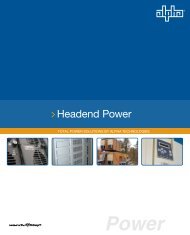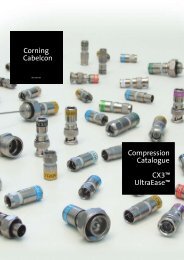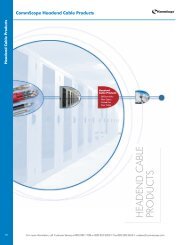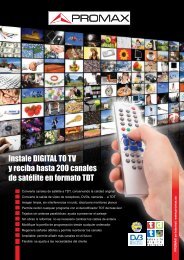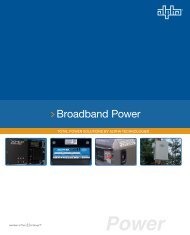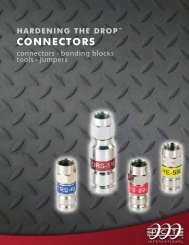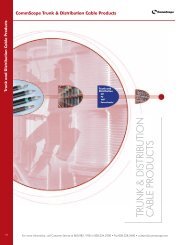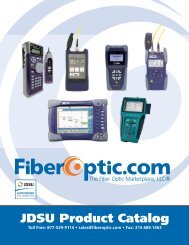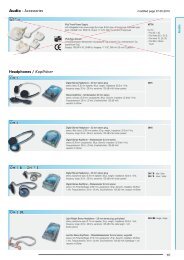C O N Q U EST C O N D U IT PRO D U C TS - KABELKON
C O N Q U EST C O N D U IT PRO D U C TS - KABELKON
C O N Q U EST C O N D U IT PRO D U C TS - KABELKON
You also want an ePaper? Increase the reach of your titles
YUMPU automatically turns print PDFs into web optimized ePapers that Google loves.
ConQuest ®<br />
Cable-In-Conduit<br />
Important Installation Information<br />
Cable Withdrawal<br />
ConQuest ®<br />
CIC conduit is slightly longer than the<br />
coaxial cable it contains. Allow an average of 1.5% of<br />
cable withdrawal back toward the reel during unspooling<br />
(example: 2000’ of conduit will yield 1970’ of cable).<br />
Cable withdrawal will be greater as you approach the end<br />
of the reel.<br />
Cut the Restraint<br />
Prior to installation of coaxial CIC, remove the conduit<br />
end cap and cut the cable restraint. This relaxes the cable<br />
and transfers all of the pulling tension to the conduit. When<br />
deploying fiber optic CIC, DO NOT remove the conduit<br />
end cap or cut the cable restraint prior to installation.<br />
Bending Technique<br />
ConQuest Coaxial CIC can be easily shaped by rolling a<br />
bend into it. Take 10 - 12 feet (3 - 3.5 meters) of conduit<br />
and pull the free end of it towards you forming a “horizontal<br />
U”. Push into the bend lightly and roll the entire radius<br />
of the conduit forward.<br />
INCORRECT METHOD<br />
DO NOT bend the<br />
conduit any further once do NOT<br />
press<br />
it begins to show signs down with<br />
your foot<br />
of ovality, i.e. begins to<br />
bulge. DO NOT press<br />
down on the conduit with<br />
your foot as you bend it.<br />
CORRECT METHOD<br />
ConQuest ® Conduit Products<br />
Payoff<br />
When installing ConQuest, pay-off the reel from underneath<br />
and in as direct a line as possible to the trench to avoid unnecessary<br />
bending of the conduit or rubbing of the conduit<br />
against the reel flange.<br />
INCORRECT METHOD<br />
pull<br />
up<br />
lightly<br />
STEP #1<br />
push down<br />
lightly<br />
do not exceed minimum<br />
bend radius<br />
STEP #2<br />
backfill to support<br />
under the bend<br />
Padding<br />
Utilizing sand for “padding”, the conduit provides protection<br />
during future excavation near your facilities. The<br />
apparent change in soil condition provides warning that<br />
there is a utility buried there. This should not replace the<br />
practice of placing warning tape, but rather should serve<br />
as a supplement.<br />
CORRECT METHOD<br />
conduit pay-off under reel drum<br />
Wait One Hour<br />
The effects of stress caused from pulling conduit through<br />
existing duct will cause the conduit to elongate (or stretch)<br />
in proportion to the amount of stress but less than 2% of<br />
the total length placed. Due to this effect, it is important<br />
to pull past the duct slightly. An allowance of at least one<br />
hour needs to be given for the conduit to “relax” before<br />
cutting and trimming it.<br />
See our ConQuest Conduit Products Applications & Construction Manual for more installation instructions and product information.<br />
For more information, call Customer Service at 800.982.1708 or 828.324.2200 • Fax 828.328.3400 • custserv@commscope.com<br />
C28



